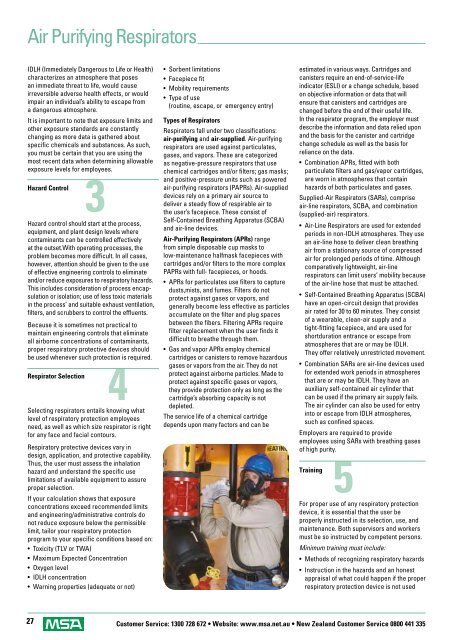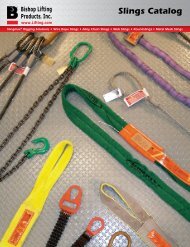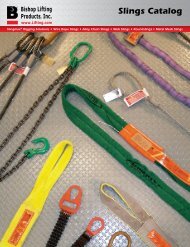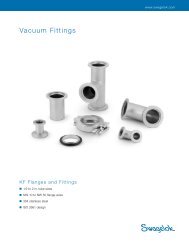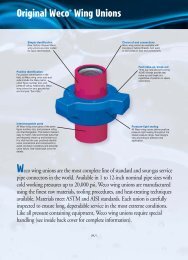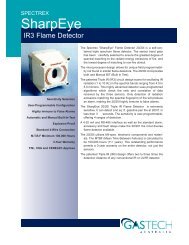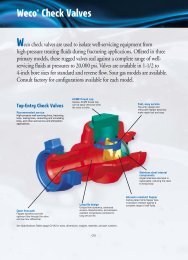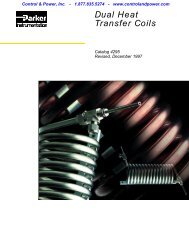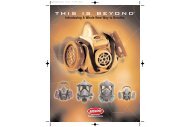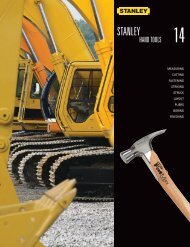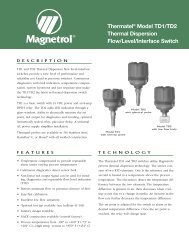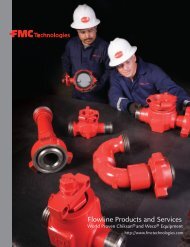Air Purifying RespiratorsParticulate ContaminatesParticulate contaminants can be classifiedaccording to their physical and chemicalcharacteristics and their physiologicaleffect on the body. The particle diameter inmicrons (1 micron = 1/25,400 inch) is of utmostimportance. Particulates below 10 micronsin diameter have a greater chance to enterthe respiratory system, and particles below5 microns in diameter are more apt to reachthe deep lung or alveolar spaces.In healthy lungs, particles from 5 to 10microns in diameter are generally removedfrom the respiratory system by a constantcleansing action that takes place in the upperrespiratory tract. However, with excessive“dust” exposures or a diseased respiratorysystem, the efficiency of the cleansing actioncan be significantly reduced.The various types of airborne particulatecontaminants can be classified as follows:Fumes - An aerosol created when solidmaterial is vaporized at high temperaturesand then cooled. As it cools, it condenses intoextremely small particles - generally less than1 micron in diameter. Fumes can result fromoperations such as welding, cutting, smelting,or casting molten metals.Dusts - An aerosol consisting of mechanicallyproduced solid particles derived from thebreaking up of larger particles. Dusts generallyhave a larger particle size when <strong>com</strong>pared tofumes. Operations such as sanding, grinding,crushing, drilling, machining, or sand blastingare the worst dust producers. Dust particlesare often found in the harmful size range of0.5 to 10 microns.Mists - An aerosol formed by liquids, whichare atomized and/or condensed. Mists canbe created by such operations as spraying,plating, or boiling, and by mixing or cleaningjobs. Particles are usually in the size range of5 to 100 microns.Gas and Vapor ContaminantsGas and vapor contaminants can be classifiedaccording to their chemical characteristics.True gaseous contaminants are similar to airin that they possess the same ability to diffusefreely within an area or container. Nitrogen,chlorine, carbon monoxide, carbon dioxide,and sulfur dioxide are examples. In termsof chemical characteristics, gaseouscontaminants may be classified as follows:Inert Gases - These include such truegases as helium, argon, neon, etc. Althoughthey do not metabolize in the body, thesegases represent a hazard, because theycan produce an oxygen deficiency bydisplacement of air.Acidic Gases - Often highly toxic, acidicgases exist as acids or produce acids byreaction with water. Sulfur dioxide, hydrogensulfide and hydrogen chloride are examples.Alkaline Gases - These gases exist as alkalisor produce alkalis by reaction with water.Ammonia and phosphine are two examples.Vapors are the gaseous state of substancesthat are liquids or solids at room temperature.They are formed when the solid or liquidevaporates.In terms of chemical characteristics, vaporouscontaminants may be classified as follows:Organic Compounds - Contaminants in thiscategory can exist as true gases or vaporsproduced from organic liquids. Gasoline,solvents, and paint thinners are examples.Organometallic Compounds - These aregenerally <strong>com</strong>prised of metals attached toorganic groups. Tetraethyllead and organicphosphates are examples.2Hazard AssessmentProper assessment of your specific hazard(s)is the first important step to protection.This requires a thorough knowledge ofprocesses, equipment, raw materials, endproducts,and by-products that can createan exposure hazard. First, you must make aninitial determination of workplace conditions.This simple calculation of exposures does notrequire sampling of the environment. Factorin workplace size, ventilation, the amount ofthe regulated substance present, the type ofoperation, and the proximity of the workersto the source of emissions.According to OSHA, personal exposuremonitoring is the “gold standard” for determiningemployee exposure. It is the most reliableapproach for assessing the level and type ofrespiratory protection required. Sampling whichuses methods appropriate for contaminants(s)should represent the worst-case exposures orenough shifts and operations to determine theaccurate range(s) of exposure.To determine an atmosphere’s oxygen contentor concentration levels of particulate and/or gaseous contaminants, air samples mustbe taken with proper sampling instrumentsduring all conditions of operation. Thesampling device and the type and frequencyof sampling (spot testing or continuousmonitoring) will be dictated by the exposureand operating conditions.Breathing zone samples are re<strong>com</strong>mendedand sampling frequency should be sufficientto assess the average exposure under thevariable operating and exposure conditions.Should contaminant concentrations exceedexposure limits re<strong>com</strong>mended by theNational Occupational Health and SafetyCommission (NOHSC), (ACGIH), OSHA, orNIOSH, hazard control procedures must beimplemented promptly.OSHA emphasizes that, because workplacesdiffer, each respirator program must betailored to the specific conditions of theworkplace. The recently revised OSHAstandard serves as a “building block standard”,because it consolidates respiratory protectionprovisions that previously were includedin sections dealing with specific chemicalsubstances.The employer is required to evaluaterespiratory hazards in the workplace, identifyrelevant workplace and use factors, and baserespirator selection on these factors.Exposure MonitoringExposure monitoring plays a critical role in therespirator selection process. The results fromsuch testing will help you determine whetherrespiratory protection is needed and, if it is, thetype of respirator that is required. Generally,respirator selection is based on three factors:• The results of your atmospheric monitoringor sampling program• The accepted ACGIH, OSHA, or NIOSHexposure limits for the substance(s) present• The maximum use concentration (of asubstance) for which a respirator can be usedExposure limits include:NOHSC National Exposure StandardsACGIH Threshold Limit Values (TLVs)OSHA Permissible Exposure Limits (PELs)NIOSH-Re<strong>com</strong>mended Exposure Levels (RELs)AIHA Workplace Environmental ExposureLevels (WEELs) These values are guidesfor exposure concentrations that healthyindividuals can normally tolerate for eighthours a day, five days a week, without harmfuleffects. Unless otherwise noted, exposurelimits are eight-hour, time-weighted-average(TWA) concentrations.In general, gas and vapor exposure limitsare expressed in ppm by volume (parts ofcontaminant per million parts of air), whileparticulate concentrations are expressedas mg/m 3 (milligrams of concentrations percubic meter of air). For substances that canexist in more than one form (particulate orgaseous), concentrations are expressed inboth values.Customer Service: 1300 728 672 • Website: www.msa.net.au • New Zealand Customer Service 0800 441 335 26
Air Purifying RespiratorsIDLH (Immediately Dangerous to Life or Health)characterizes an atmosphere that posesan immediate threat to life, would causeirreversible adverse health effects, or wouldimpair an individual’s ability to escape froma dangerous atmosphere.It is important to note that exposure limits andother exposure standards are constantlychanging as more data is gathered aboutspecific chemicals and substances. As such,you must be certain that you are using themost recent data when determining allowableexposure levels for employees.3Hazard ControlHazard control should start at the process,equipment, and plant design levels wherecontaminants can be controlled effectivelyat the outset.With operating processes, theproblem be<strong>com</strong>es more difficult. In all cases,however, attention should be given to the useof effective engineering controls to eliminateand/or reduce exposures to respiratory hazards.This includes consideration of process encapsulationor isolation; use of less toxic materialsin the process’ and suitable exhaust ventilation,filters, and scrubbers to control the effluents.Because it is sometimes not practical tomaintain engineering controls that eliminateall airborne concentrations of contaminants,proper respiratory protective devices shouldbe used whenever such protection is required.4Respirator SelectionSelecting respirators entails knowing whatlevel of respiratory protection employeesneed, as well as which size respirator is rightfor any face and facial contours.Respiratory protective devices vary indesign, application, and protective capability.Thus, the user must assess the inhalationhazard and understand the specific uselimitations of available equipment to assureproper selection.If your calculation shows that exposureconcentrations exceed re<strong>com</strong>mended limitsand engineering/administrative controls donot reduce exposure below the permissiblelimit, tailor your respiratory protectionprogram to your specific conditions based on:• Toxicity (TLV or TWA)• Maximum Expected Concentration• Oxygen level• IDLH concentration• Warning properties (adequate or not)• Sorbent limitations• Facepiece fit• Mobility requirements• Type of use(routine, escape, or emergency entry)Types of RespiratorsRespirators fall under two classifications:air-purifying and air-supplied. Air-purifyingrespirators are used against particulates,gases, and vapors. These are categorizedas negative-pressure respirators that usechemical cartridges and/or filters; gas masks;and positive-pressure units such as poweredair-purifying respirators (PAPRs). Air-supplieddevices rely on a primary air source todeliver a steady flow of respirable air tothe user’s facepiece. These consist ofSelf-Contained Breathing Apparatus (SCBA)and air-line devices.Air-Purifying Respirators (APRs) rangefrom simple disposable cup masks tolow-maintenance halfmask facepieces withcartridges and/or filters to the more <strong>com</strong>plexPAPRs with full- facepieces, or hoods.• APRs for particulates use filters to capturedusts,mists, and fumes. Filters do notprotect against gases or vapors, andgenerally be<strong>com</strong>e less effective as particlesaccumulate on the filter and plug spacesbetween the fibers. Filtering APRs requirefilter replacement when the user finds itdifficult to breathe through them.• Gas and vapor APRs employ chemicalcartridges or canisters to remove hazardousgases or vapors from the air. They do notprotect against airborne particles. Made toprotect against specific gases or vapors,they provide protection only as long as thecartridge’s absorbing capacity is notdepleted.The service life of a chemical cartridgedepends upon many factors and can beestimated in various ways. Cartridges andcanisters require an end-of-service-lifeindicator (ESLI) or a change schedule, basedon objective information or data that willensure that canisters and cartridges arechanged before the end of their useful life.In the respirator program, the employer mustdescribe the information and data relied uponand the basis for the canister and cartridgechange schedule as well as the basis forreliance on the data.• Combination APRs, fitted with bothparticulate filters and gas/vapor cartridges,are worn in atmospheres that containhazards of both particulates and gases.Supplied-Air Respirators (SARs), <strong>com</strong>priseair-line respirators, SCBA, and <strong>com</strong>bination(supplied-air) respirators.• Air-Line Respirators are used for extendedperiods in non-IDLH atmospheres. They usean air-line hose to deliver clean breathingair from a stationary source of <strong>com</strong>pressedair for prolonged periods of time. Although<strong>com</strong>paratively lightweight, air-linerespirators can limit users’ mobility becauseof the air-line hose that must be attached.• Self-Contained Breathing Apparatus (SCBA)have an open-circuit design that providesair rated for 30 to 60 minutes. They consistof a wearable, clean-air supply and atight-fitting facepiece, and are used forshortduration entrance or escape fromatmospheres that are or may be IDLH.They offer relatively unrestricted movement.• Combination SARs are air-line devices usedfor extended work periods in atmospheresthat are or may be IDLH. They have anauxiliary self-contained air cylinder thatcan be used if the primary air supply fails.The air cylinder can also be used for entryinto or escape from IDLH atmospheres,such as confined spaces.Employers are required to provideemployees using SARs with breathing gasesof high purity.5TrainingFor proper use of any respiratory protectiondevice, it is essential that the user beproperly instructed in its selection, use, andmaintenance. Both supervisors and workersmust be so instructed by <strong>com</strong>petent persons.Minimum training must include:• Methods of recognizing respiratory hazards• Instruction in the hazards and an honestappraisal of what could happen if the properrespiratory protection device is not used27 Customer Service: 1300 728 672 • Website: www.msa.net.au • New Zealand Customer Service 0800 441 335


